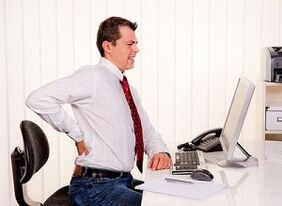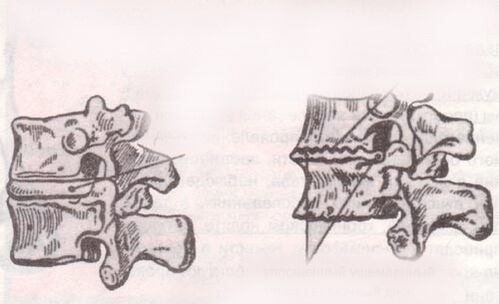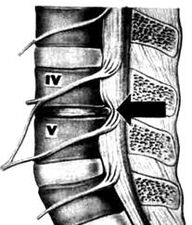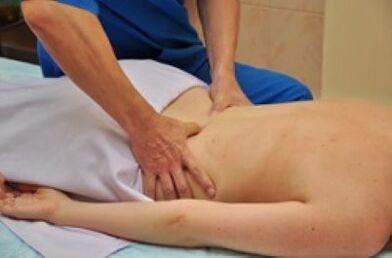The lumbosacral spine osteochondrosis is a distrophic spinal disease in which the normal structure of the entire spinal column, especially the intervertebral discs, is gradually destroyed.It should be said that not only the back suffers, but also the whole body, especially the pelvic organs and the lower limbs.

Causes of development
Public lumbar region experiences a human life a colossal vertical load that cannot even compensate for the large size of the vertebrae.Therefore, the smallest shift of the human body, a decrease in the lower back of the back, overweight, injuries, improper movements and much more can lead to the development of the disease.In addition, you must always remember the age -related changes in the spine about individuals.

In summary, the most common risk factors can be distinguished, all of which leads to osteochondrosis of the lumbar:
- Uneven and irregular load of the spine (raising severity from an oblique position, etc.).
- Overweight (almost every kilogram is important).
- Rumber injuries, including sports.
- Weakening of the muscle lining (longer work in a monotonous position, etc.).
- Mapping diet, bad in minerals and vitamins.
Symptoms
The symptoms of the disease may be quite different, but the main signs of osteochondrosis usually develop in three syndromes:
- Vertobroogenic lumbalgia (lumbago synonym).
- Vertro -Carbon lumboyshalgia.
- Vertro -carbon ischialgia (inflammation of the sciatic nerve).
In addition to pain in the lumbar region (with or without the legs, with or without gluteal, inguinal areas), the tension of the lower muscles, the weakness of the legs, the crunching of the lower rear movements and the difficulties of lumbar movement in the lumbar region should be distinguished:
- Numbness in the legs and the climbing feeling of the gooseamombs in the legs.
- Cramps in the legs.
- Pelvic disorders (delay or incontinence of urine, constipation or diarrhea).
- Weakness in certain groups of leg muscles.
These complaints can direct the neurologist to the level of damage to the spine, and may perform differential diagnosis with other diseases of the spine.
Diagnostics and x -gay signs

Only one type of instrumental method should be diagnosed with osteochondrosis - radiological.Imagine the full structure of the spine in modern medicine the best MSCT or MRI examination allows, but simple radiography has not lost its estimated value (as a screening).It is important to note that the main stage of diagnosis of spine problems is a medical examination, which sometimes allows the diagnosis to be made without examination.
In neurological status, pain is painted when the spicy processes of the vertebrae, the tension of the lower back muscles, and if there is only osteochondrosis, there should not be symptoms such as: reduced tendon reflexes, impaired sensitivity, tension symptoms (signs of movement).legs.In the presence of these symptoms, differential diagnostics should be performed with the disorder of the disc and other more severe diseases of the spine.
Treatment
Treatment of the disease involves long -term complete therapy.Degraming, non -drug supplementary methods are the directions of removing multiple drugs, and the preventive method of physiotherapy, which is used partly during the acute period and does not lose its relevance to this day.
medicine
This is myoorlaxing therapy, a combination of anti -inflammatory pathogens, and the use of neuroprotective drugs.The choice of medicines and the calculations of the dosage are derived from the weight of a person, the gender, and the presence of concomitant diseases.
During the acute period, it is advisable to inject drugs such as diclofenac, meloxicam.At the same time, it is started in parallel to remove muscle cramps and protect the nerve fibers to protect damage.
No -drog

This is represented by phyode and manual influences.Given the mass of muscle groups, the rather extensive level of the anatomical zone, physiotization can only be a complementary method.DDT, electrophoresis, magnetic therapy can be used that allow the effect of the drugs.
However, massage and manual therapy can sometimes completely stop the symptoms of lumbar osteochondrosis, even without the support of medicines.This is due to the fact that the muscle cramps can be removed quite well and the pain is not always provoked by the inflammatory process, sometimes only the careless movement leads to pain, the consequences of which are effectively eliminated during the first hours after pain.
The purpose of osteochondrosis of the lumbar region is to provide and strengthen the muscles of the back.In the presence of the diagnosis established, lumbar osteochondrosis should be involved in daily physiotherapy exercises.The general rules (restriction of excessive physical activity, restriction of hypothermia), body weight control and the body of osteochondrosis of the lumbar region can sometimes be forgotten.
























